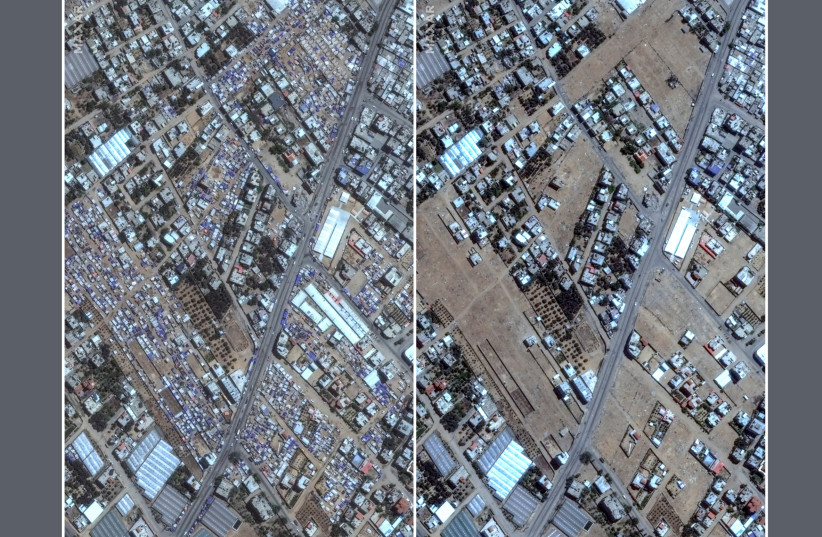by Yonah Jeremy Bob
IDF controls most of Philadelphi Corridor, 30% of Rafah • Military unsure where Sinwar is
 |
The IDF has succeeded in evacuating around 950,000 Palestinian civilians in only two weeks since May 6, the military revealed on Monday.
In addition, around 30-40% of Rafah is now under IDF control, not merely a small portion of the eastern sector, and about 60-70% of Rafah has been completely evacuated.
The remaining Rafah civilians, estimated at around 300,000-400,000, are almost all near the Gaza coast Tel al-Sultan area.
This is despite US predictions that the civilian population could not be evacuated without a huge death count or without leaving around four months to do so.
Of those evacuated, the overwhelming majority moved northwest to al-Muwasi, while a smaller number moved to central Gaza.


A much less significant number returned to Khan Yunis, though that had been discussed as a real possibility for potentially hundreds of thousands of civilians.
Regarding the battle, though there certainly is significant resistance from the four Hamas battalions in Rafah, the IDF said it had mostly taken them by surprise.
After initial early and more unified resistance, the impression is that the battalions have started a process of being taken apart, fleeing, or hiding to try to fight a guerilla-style battle at a later date.
Another possibility is that Hamas's battalions will put up more of a fight for Tel al-Sultan, but generally to date, the terror group's battalions have not put up as hard a fight as Hamas did in the initial battles for Gaza City in October-November or for Khan Yunis in December.
IDF has taken over most of the Philadelphi Corridor
Next, the IDF has taken control of the majority, though not all, of the Philadelphi Corridor with Egypt.
The military has already destroyed many cross-border tunnels on the Corridor, Hamas' main remaining method for receiving new weapons, but still is not sure yet how many tunnels remain.
In other parts of Gaza, it has taken months for the IDF to get a fuller picture of the tunnel challenge.
Despite Egypt's anger at Israel for the Rafah operation and its closing the Rafah Crossing regarding humanitarian aid, the IDF said that military relations on the ground with Cairo have remained strong, and there have been no violent incidents between the sides.
Other than a tiny number, there have also been no Palestinians penetrating into Egypt, which had been Cairo's biggest fear.
The IDF said that it has observed its understandings with Egypt of how to carry out the Rafah operation with utmost precision.
IDF less sure than ever about Sinwar's whereabouts
Unfortunately, the IDF provided no updates on the status of the hostages held in Rafah, and seemed less sure than ever about where Gaza Chief Yahya Sinwar is hiding.
It was also possible that Hamas may have moved the hostages out of Rafah as part of the large number of civilians who fled, and the same could be true for Sinwar.
The IDF said the Rafah operation was incredibly complex and that it had achieved significant victories despite many restraints on how it could fire on Hamas to avoid even the possibility that a misfire might hit nearby Egyptian troops.
In addition, the IDF said it had seized and destroyed a very large quantity of rockets and rocket platforms in Rafah, the last place where it said Hamas might still have a larger quantity of rockets, including long-range rockets.
Besides Rafah, the IDF said it caught Hamas by surprise when it reinvaded Jabalia. There, it said that the civilians were moved in a much shorter time than from Rafah, with warnings issued in the morning, and the invasion starting in the afternoon on the same day.
The IDF has found additional tunnels in Jabalia and took apart an attempt by Hamas to establish a new command center there for unified fighting.
Unlike in Rafah, the Hamas fighters in Jabalia are not viewed as having as much of an opportunity to flee, though the IDF still did not give a set timeframe for finishing the latest Jabalia reinvasion.
If for months, there was reference to one to two Hamas battalions operating in central Gaza, the IDF said that these battalions are also being taken apart, by a mix of airstrikes and targeted invasions.
A smaller force contingent is needed for these attacks because the central Gaza forces were much smaller than the forces remaining in Rafah, but the bottom line was that the IDF could be converging on a point where all 24 Hamas battalions would be dismantled.
IDF sources suggested that this would signal achieving the first goal of the war, toppling Hamas as a military organization, even if other goals of the war, removal of Hamas as a political authority and return of the hostages, may still remain open questions.
According to one prediction, fighting a Hamas insurgency will require significant military resources at a minimum until October of this year, and possibly even somewhat beyond.
Yonah Jeremy Bob
Source: https://www.jpost.com/israel-hamas-war/article-801903
No comments:
Post a Comment